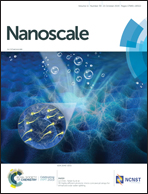One-step hydrothermal synthesis of cobalt–vanadium based nanocomposites as bifunctional catalysts for overall water splitting†
Abstract
Designing low-cost and high-active bifunctional catalysts for overall water splitting has attracted increasing research interest. Herein, the brilliant overall water splitting performance of cobalt–vanadium bimetal-based nanocomposites is explored. Co–V based nanocomposites are synthesized through a one-step hydrothermal method, in which the cobalt species is introduced into the lepidocrocite VOOH and further cobalt vanadium oxide is formed. The additive level of cobalt is optimized and the corresponding effect on electrocatalytic activity is also investigated in this work, systematically. The targeted catalyst (denoted as Co0.2-VOOH) exhibits a unique sheet-like morphology, resulting in the high exposure of catalytically active sites. When used as the bifunctional catalyst, Co0.2-VOOH can achieve a current density of 10 mA cm−2 at the overpotentials of 210 mV for water oxidation and 130 mV for hydrogen generation, respectively. Notably, it only requires low cell voltages of 1.57 and 1.74 V to drive the catalytic current densities of 10 and 100 mA cm−2 during the water splitting process. This work significantly indicates that cobalt–vanadium based materials are promising alternatives for overall water splitting.



 Please wait while we load your content...
Please wait while we load your content...